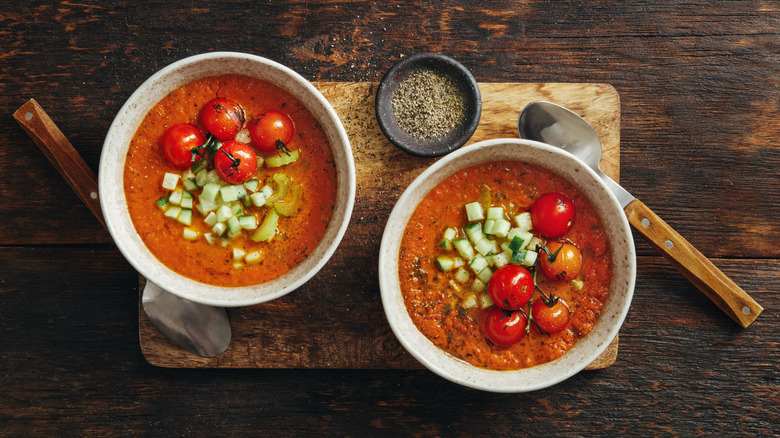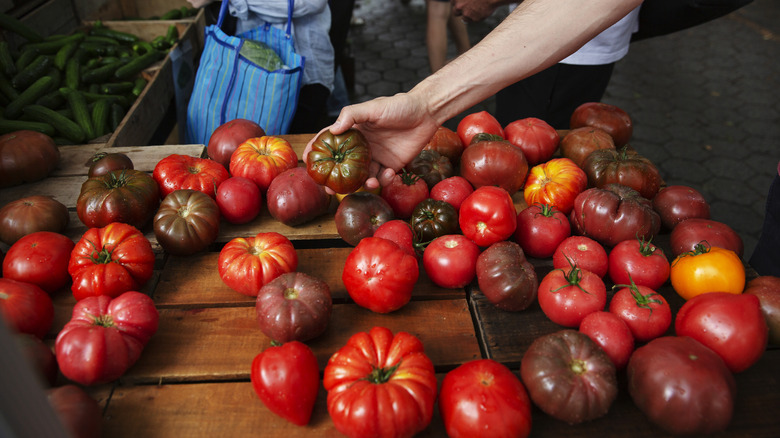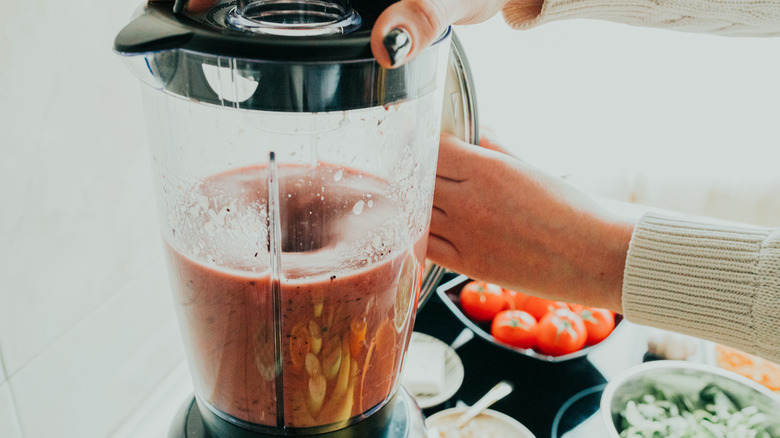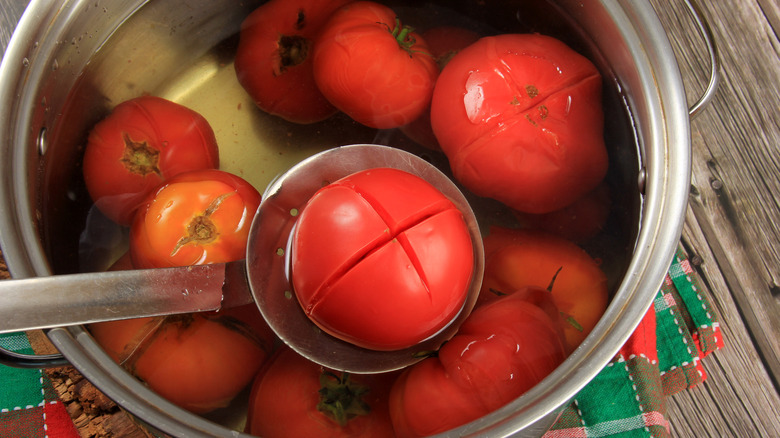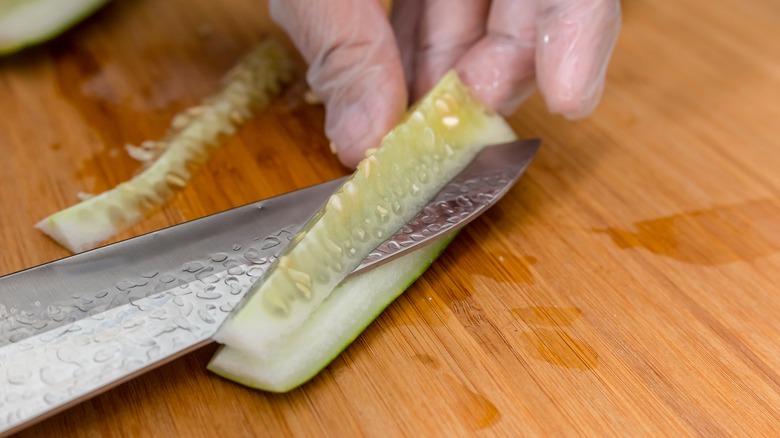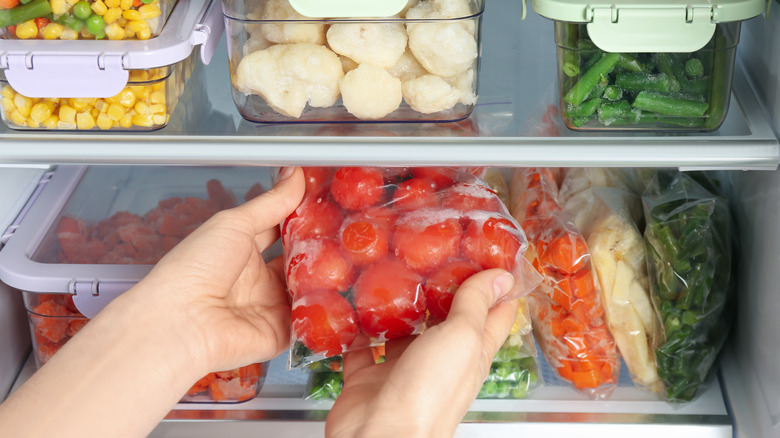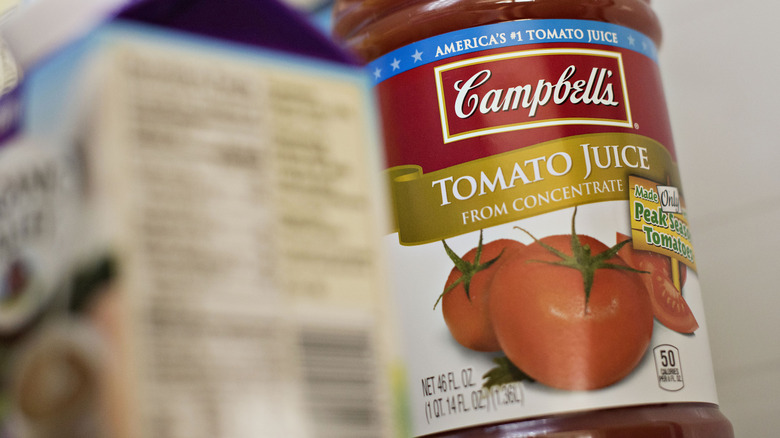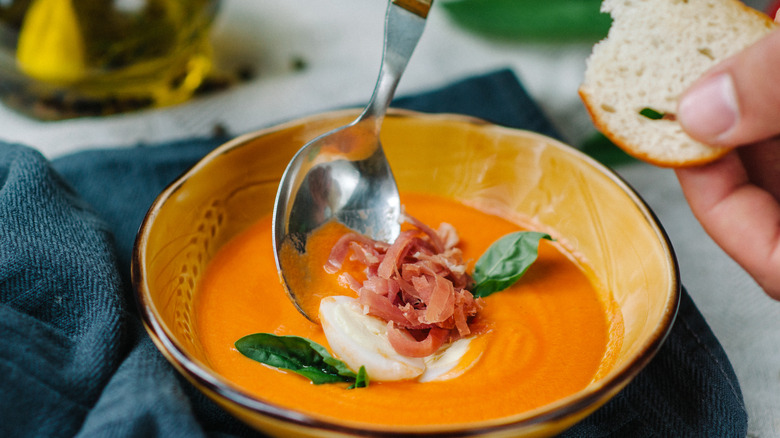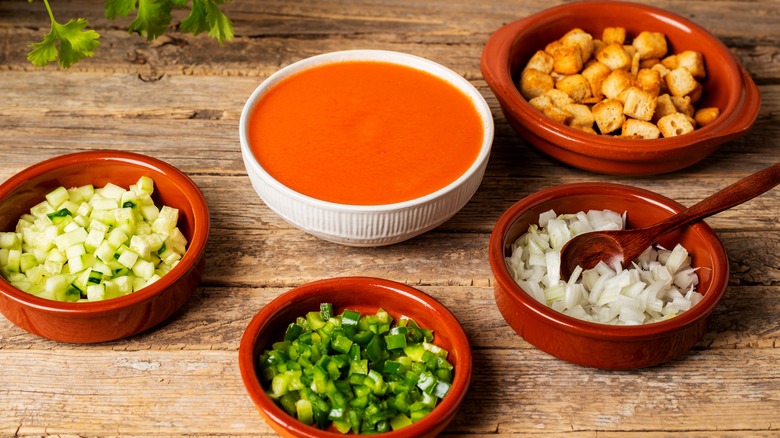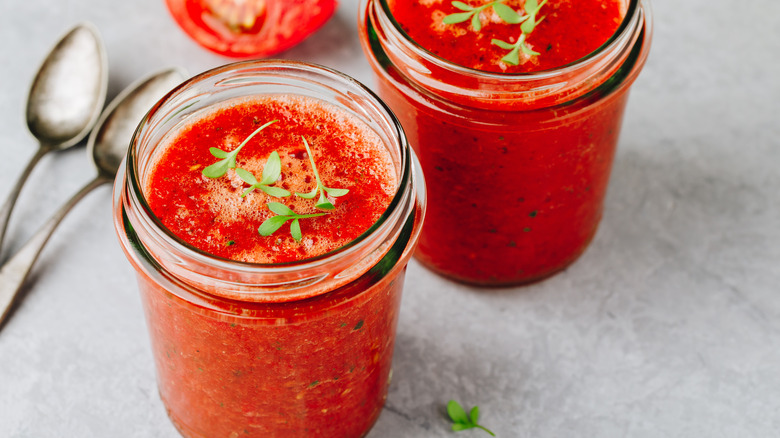12 Mistakes You're Making With Gazpacho
Andalusia, one of the warmest regions in Spain, is known for its gloriously sunny year-round weather and sizzling hot summers. So it's no surprise that this area of southern Spain is considered the origin of gazpacho, a light and refreshing chilled soup made with raw, blended vegetables. Variations like peach and cantaloupe gazpacho and green gazpacho have evolved over time — but the most popular recipes consist of ripe tomatoes blended with cucumbers, bell peppers, garlic, onions, vinegar, and olive oil, all thickened with bread. Gazpacho comes to mind during the peak of summertime when turning on our ovens or stoves isn't so appealing, and a big bowl of chilled gazpacho is an easy way to stay cool.
While gazpacho is simple to make by puréeing vegetables in a blender, you can make a surprising number of blunders. We've compiled the common mistakes people make when preparing gazpacho so you'll know what to avoid when preparing this warm-weather dish at home. Steering clear of these pitfalls will ensure that your gazpacho has the best taste and texture possible, a far cry from the all-too-easy outcome of dull, soupy salsa. Let this cold Spanish soup shine in its simplicity; when made well, gazpacho is a delightful way to taste summer's bounty.
1. Making it out of season
The quality of your ingredients matters in cooking — especially when making gazpacho, a no-cook blended soup of raw vegetables. Ingredient quality directly affects the taste of your gazpacho, so make sure to use produce at its peak. If the vegetables are lackluster and tasteless, it's a sure bet that your gazpacho will turn out uninspired and flavorless. When gazpacho is made with the season's best, ripe produce, there's nothing better.
Your tomatoes should be the sweetest, ripest ones you can find. You can use any large, juicy, fresh tomato variety for gazpacho, such as Roma, heirloom, or vine-ripened tomatoes. But if it's not July or August (peak tomato season), consider roasting the tomatoes in the oven for extra flavor before blending them up for gazpacho. Season halved tomatoes with olive oil, sea salt, pepper, garlic, and herbs of your choice, then pop them into a hot oven. The dry heat will enhance the flavor of the tomatoes through caramelization and browning, resulting in enriched sweetness and balanced acidity.
2. Not utilizing a high-powered blender
High-powered blenders, like Vitamix and Ninja, are the best kitchen appliances for pulverizing raw vegetables for a silky smooth gazpacho. These strong blenders also do a great job whipping up the perfect emulsification for a creamy consistency when streaming olive oil into your gazpacho. Another benefit of using a blender? Speed. The powerful blades and the narrow shape of the blender jar purée the vegetables quickly and efficiently for gazpacho that's ready in minutes.
Gazpacho was traditionally made by pounding the vegetables using a mortar and pestle. The benefit of this laborious method was that the gazpacho stayed cool, so little to no chill time was needed. Some people may avoid using a blender for this reason. But since gazpacho improves with age, any added heat from making the soup in a blender isn't a big deal — you'll want to let the soup sit for a couple of hours anyway to allow the flavors of the vegetables to meld with the vinegar and olive oil.
If you prefer your gazpacho on the chunkier side, you can use a food processor instead. Using the processor's pulse feature, you can retain small chunks of vegetables to add more texture. In a pinch, you could also use an immersion blender, but you'd need a deep bowl (like a bain-marie) to prevent the chance of soup splattering onto your kitchen walls. Our advice? Leave the immersion blender in the drawer and bust out the blender instead.
3. Blending in the tomato and cucumber skins
To peel or not to peel? We say peel, and here's why. Removing the skins from your tomatoes and cucumbers will remove any chance of tiny fibrous bits floating in your gazpacho. Additionally, the skins contain naturally occurring flavonoid compounds, which can impart a bitter flavor. So before you toss those tomatoes and cucumbers into the blender, take the time to remove their skins, and it will pay dividends. It's worth noting that some varieties of cukes, like English cucumbers, have thin peels that are easy to pulverize and not as bitter as conventional cucumbers, so you can leave their skins on.
Blanching is the simplest way to remove tomato skins. Use a sharp paring knife to cut an "x" into each tomato's bottom end, then lower them into boiling water for about 30 seconds. Remove the tomatoes with a slotted spoon and immediately plunge them into a bowl of ice-cold water. The extreme change in temperature loosens the skins, allowing them to slip off easily when peeled, starting at the "x." Sure, blanching tomatoes is a tedious step when making gazpacho, but it's worth doing to ensure your soup is uniformly smooth with no acerbic notes.
4. Leaving in the tomato and cucumber seeds
When you leave seeds in your tomatoes and cucumbers, you run a few risks. The first is that there's a chance your gazpacho will turn out slightly bitter from the seeds. Secondly, the watery membranes surrounding the seeds can dilute the flavor of your gazpacho. Lastly, including the seeds can prevent the gazpacho from having an ultra-smooth consistency. Unless your blender is strong enough to pulverize everything in its path, you'll likely have bits of seeds in your soup for an unpleasant texture. Removing the tomato and cucumber seeds will yield a gazpacho with an ultra-smooth, perfect consistency without being watered down.
The time it takes to deseed the tomatoes depends on how many your recipe calls for, but per tomato, it only takes a few seconds. Simply cut a blanched, peeled tomato in half and use your hands to scoop or squeeze out the seeds. To deseed a cucumber, cut a peeled cucumber in half lengthwise, then use a small spoon or melon baller to scrape out the seeds. Or, cut the halved cucumber in half again lengthwise and use a sharp paring knife to slice away the center seeds. Once you remove the seeds from the tomatoes and cucumbers, the preparation time for your gazpacho is less than 10 minutes.
5. Not freezing the vegetables first
We all know that freezing food can save us time and money, but did you know it's also the secret to more flavorful gazpacho? It all comes down to water content. Vegetables high in water content — like the cucumbers, tomatoes, onions, and bell peppers used in gazpacho — aren't prime candidates for freezing because they turn mushy when thawed. However, this soft, pulpy consistency is precisely what you want when making gazpacho. As the frozen vegetables are puréed in the blender, they will give your soup a luxuriously smooth texture.
Here's the science behind this: When you place your gazpacho vegetables in the freezer, you allow the water in their cell walls to freeze and expand. As the cell walls thaw and fracture in the blender, they become soft with a pulpy consistency — exactly what is needed for smooth, creamy gazpacho. Additionally, the broken cell walls release flavor into the thawing liquid, which, when used in making gazpacho, intensifies the pungency and depth of the soup.
6. Choosing the wrong vinegar
Acids are an essential component in cooking. They contribute to flavor by adding bright notes, amplifying other ingredients, and balancing sweetness, bitterness, and spiciness. A touch of acid can round out the final flavors of a dish for a more pleasurable eating experience, often taking it from good to great.
Vinegar is the essential acidic ingredient of gazpacho — specifically, sherry vinegar. This delicious vinegar is made from sherry wine, grown from palomino fino grapes in the Jerez region of Spain. The sherry wine is first aged in oak barrels to develop a rich, complex flavor, then acetified for fermentation into vinegar. The resulting product is lightly sweet with a unique nutty flavor and notes of caramel that add pizzazz when served with food.
When used in gazpacho, sherry vinegar boosts the acidity of the tomatoes, giving the soup its trademark zesty flavor. Sherry vinegar also has a milder acidity than other kinds of vinegar, making it great for enhancing the flavor of other ingredients without overpowering them. If you want a vibrant gazpacho, make sure to add a splash of sherry vinegar — which also happens to be the vinegar Chef José Andrés uses to make his gazpacho super flavorful.
7. Not using extra-virgin olive oil to add creaminess
Olive oil is one of the most important ingredients in gazpacho, contributing to the soup's color, texture, and taste. Without this liquid fat, gazpacho would be a one-dimensional soup of puréed vegetables. Olive oil adds flavor, weight, body, and mouthfeel, making the gazpacho much more satisfying.
The best time to incorporate olive oil into your gazpacho is after the vegetables have been blended together. With the blender running, stream in the olive oil to slowly incorporate and emulsify the soup, creating a creamy, almost fluffy texture. Your gazpacho will be ultra-velvety, smooth, and irresistible.
It's essential to use high-quality extra-virgin olive oil — and avoid inferior brands like the plague. Yes, extra-virgin olive oil is a bit pricey, but you pay for what you get. A light or low-quality olive oil will surely ruin an otherwise great gazpacho. For the best-flavored gazpacho, bite the bullet and splurge on high-quality extra-virgin olive oil to add superior richness and taste.
8. Adding liquids like tomato juice and water
Some gazpacho recipes call for tomato juice, water, or broth because the additional liquid gives the gazpacho a soup-like consistency that can help the blender purée more efficiently. However, the pitfalls of doing this include diluting the flavor of your gazpacho and tainting the incomparable taste of fresh, in-season produce. Remember, too, that store-bought tomato juice has a distinct taste and is often made with other ingredients that will change the flavor of your gazpacho. The solution? Use the freshest, ripest produce available instead of relying on liquids like tomato juice and water. If you use in-season tomatoes, cucumbers, bell peppers, and onions, you should not need to add liquid to your gazpacho — aside from the sherry vinegar and olive oil.
If your gazpacho is still too thick after adding all your ingredients, you can add a minimal amount of water to thin the soup out, but consider that this will dilute the flavor. Make sure to add the water a little at a time, as gazpacho can go from thick to thin very quickly.
9. Skipping the bread for thickening
If you've been staring at leftover bread sitting on your kitchen counter all week, we have the perfect way to put that days-old loaf to use. Leftover bread is the ingredient you should be using to thicken your gazpacho. When stale bread is blended into your soup, it helps thicken it by absorbing excess liquid. The resulting soup is heartier in texture and has more body for improved mouthfeel. The bread also soaks up all the deliciously salty, fatty, and acidic flavors of the soup, making each mouthful more flavorful.
You can use different types of bread to thicken your gazpacho — everything from baguette and challah to a simple slice of Wonder bread. You can even experiment using garlic bread, pumpernickel, or sourdough to impart a unique flavor to your gazpacho. Or, if you're into homemade bread crumbs, make a batch and blend them into your gazpacho a tablespoon at a time until the soup thickens to your desired consistency. Need to avoid gluten? Here's a pro tip: Use ground almonds as a gluten-free alternative to bread.
The best way to incorporate bread into your gazpacho is to tear it up and allow the pieces to soften in the soup. After about 10 minutes, turn the blender on, and the soaked pieces of bread will incorporate into the soup seamlessly. If you don't have 10 minutes to spare, dip the bread in cold water, squeeze out the water with your hands, then purée the bread into the soup — no soaking time needed.
10. Eating it right away
Gazpacho was developed as a means to nourish while staying cool. Anyone who has enjoyed gazpacho on a hot, sticky day knows how incredibly refreshing and restorative this chilled soup can be. But unfortunately, one of the most common mistakes in making gazpacho is eating it right after it's made. We know how tempting it is to eat your gorgeous gazpacho right after making it, but it needs to spend some time in the refrigerator beforehand. Let your gazpacho chill in the fridge for at least a couple of hours so you can enjoy it the way it was meant to be eaten: ice-cold.
This critical resting period also gives the flavors of your gazpacho time to meld and fully develop. Because the flavors may change slightly under cold temperatures, it's important to reseason the soup after chilling. If patience isn't your forte or your guests show up earlier than expected, you can chill the gazpacho in smaller portions for faster results. Or, consider making your gazpacho the day before and chilling it overnight.
11. Neglecting to add toppings for texture and flavor
Most people find gazpacho a little boring when eaten on its own. The solution? Toppings, toppings, and more toppings. By including toppings with your gazpacho, you add heft, texture, and flavor, so make sure to serve them with your gazpacho. Toppings make gazpacho a filling meal that's enjoyable to look at and satisfying to eat. You should add toppings to the soup right before serving. Or, better yet, create a spread for a toppings bar and let everyone choose their favorite ones. A toppings bar makes eating gazpacho a meal and a party at the same time.
So many different foods can be used as gazpacho toppings — just be sure to finely dice the toppings into bite-sized pieces or smaller to make for easier eating and a better balance in taste. You can top your gazpacho with the same vegetables used to make the soup, like tomatoes, cucumber, peppers, onions, and croutons. But you can also veer from the recipe and opt for toppings like crème fraîche for creaminess, chopped fruits for eye appeal, toasted nuts for texture, or cold poached shrimp and Spanish cured ham for heartiness.
12. Storing one large batch instead of individual servings
Most gazpacho recipes yield a large batch, which can end up using a lot of storage space in your refrigerator. So we recommend portioning your gazpacho into individual servings to save room in your fridge for other items. These smaller portions of soup will also maintain their flavor and consistency better than one large batch. And you'll also be more likely to eat the gazpacho if it's pre-portioned into a grab-and-go meal. Whether you're willing to admit it or not, ease of convenience plays a big part in what we eat.
We think 8-ounce mason jars are the ideal containers for storing individual servings of gazpacho. These glass jars are sturdy and airtight, so you can be confident that your gazpacho will taste fresh for days. And since they're made of clear glass, you'll be able to see what's in them, reducing the chance of them getting pushed back into the forgotten, deep corners of your refrigerator. These economical mason jars are great for stacking, too, leaving you even more room in the refrigerator for other foods. Lastly, storing gazpacho in mason jars makes it easier and faster to re-emulsify the soup, which tends to separate as it sits. You only need to shake the jar briskly for a few seconds, and your gazpacho will come together beautifully.
